clock RENAULT MEGANE 2005 X84 / 2.G Owners Manual
[x] Cancel search | Manufacturer: RENAULT, Model Year: 2005, Model line: MEGANE, Model: RENAULT MEGANE 2005 X84 / 2.GPages: 250, PDF Size: 5.72 MB
Page 11 of 250
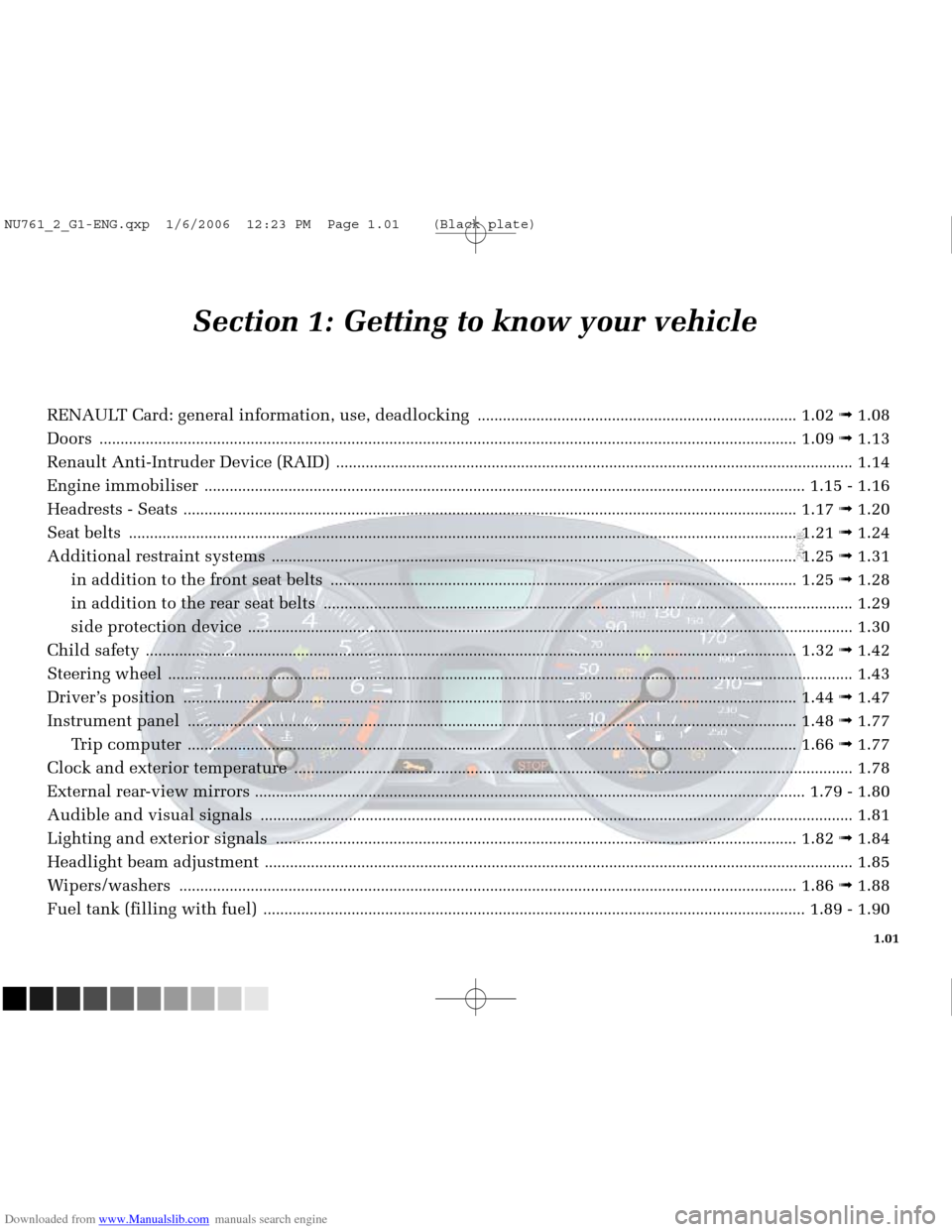
Downloaded from www.Manualslib.com manuals search engine
NU761_2_G1-FRA.qxd 10/11/05 15:52 Page 1.01
1.01
Section 1: Getting to know your vehicle
RENAULT Card: general information, use, deadlocking ........................................................................\
....1.02 ➟1.08
Doors
........................................................................\
....................................................... .......................................1.09 ➟1.13
Renault Anti-Intruder Device (RAID)
........................................................................\
...................................................1.14
Engine immobiliser
........................................................................\
....................................................... ................1.15 - 1.16
Headrests - Seats
........................................................................\
....................................................... ...................1.17 ➟1.20
Seat belts
........................................................................\
....................................................... ................................1.21 ➟1.24
Additional restraint systems
........................................................................\
.....................................................1.25 ➟1.31
in addition to the front seat belts
........................................................................\
.......................................1.25 ➟1.28
in addition to the rear seat belts
........................................................................\
......................................................1.29
side protection device
........................................................................\
....................................................... .................1.30
Child safety
........................................................................\
....................................................... ............................1.32 ➟1.42
Steering wheel
........................................................................\
....................................................... ....................................1.43
Driver’s position
........................................................................\
....................................................... ...................1.44 ➟1.47
Instrument panel
........................................................................\
....................................................... ..................1.48 ➟1.77
Trip computer
........................................................................\
....................................................... ..................1.66 ➟1.77
Clock and exterior temperature
........................................................................\
....................................................... ......1.78
External rear-view mirrors
........................................................................\
....................................................... ....1.79 - 1.80
Audible and visual signals
........................................................................\
....................................................... ..............1.81
Lighting and exterior signals
........................................................................\
....................................................1.82 ➟1.84
Headlight beam adjustment
........................................................................\
....................................................... .............1.85
Wipers/washers
........................................................................\
....................................................... ....................1.86 ➟1.88
Fuel tank (filling with fuel)
........................................................................\
....................................................... ..1.89 - 1.90
NU761_2_G1-ENG.qxp 1/6/2006 12:23 PM Page 1.01 (Black plate)
Page 38 of 250
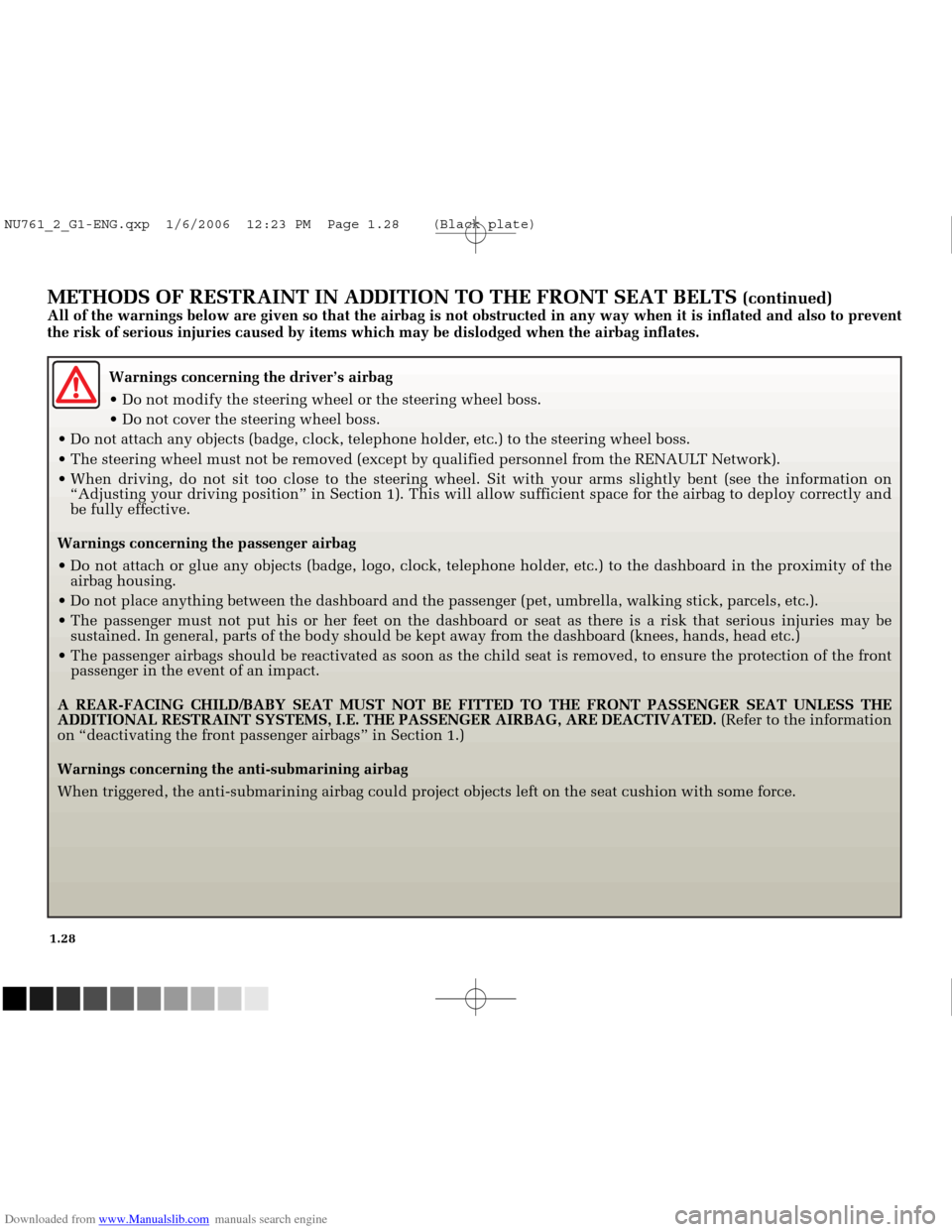
Downloaded from www.Manualslib.com manuals search engine
NU761_2_G1-FRA.qxd 10/11/05 15:53 Page 1.28
1.28
METHODS OF RESTRAINT IN ADDITION TO THE FRONT SEAT BELTS (continued)All of the warnings below are given so that the airbag is not obstructed\
in any way when it is inflated and also to prevent
the risk of serious injuries caused by items which may be dislodged when\
the airbag inflates.Warnings concerning the driver’s airbag
Do not modify the steering wheel or the steering wheel boss.
Do not cover the steering wheel boss.
Do not attach any objects (badge, clock, telephone holder, etc.) to the steering wheel boss.
The steering wheel must not be removed (except by qualified personnel\
from the RENAULT Network).
When driving, do not sit too close to the steering wheel. Sit with your \
arms slightly bent (see the information on “Adjusting your driving position” in Section 1). This will allow \
sufficient space for the airbag to deploy correctly and
be fully effective.
Warnings concerning the passenger airbag
Do not attach or glue any objects (badge, logo, clock, telephone holder\
, etc.) to the dashboard in the proximity of the airbag housing.
Do not place anything between the dashboard and the passenger (pet, umb\
rella, walking stick, parcels, etc.).
The passenger must not put his or her feet on the dashboard or seat as t\
here is a risk that serious injuries may be sustained. In general, parts of the body should be kept away from the da\
shboard (knees, hands, head etc.)
The passenger airbags should be reactivated as soon as the child seat is\
removed, to ensure the protection of the front passenger in the event of an impact.
A REAR-FACING CHILD/BABY SEAT MUST NOT BE FITTED TO THE FRONT PASSENGER \
SEAT UNLESS THE
ADDITIONAL RESTRAINT SYSTEMS, I.E. THE PASSENGER AIRBAG, ARE DEACTIVATED\
. (Refer to the information
on “deactivating the front passenger airbags” in Section 1.)
Warnings concerning the anti-submarining airbag
When triggered, the anti-submarining airbag could project objects left o\
n the seat cushion with some force.
NU761_2_G1-ENG.qxp 1/6/2006 12:23 PM Page 1.28 (Black plate)
Page 88 of 250
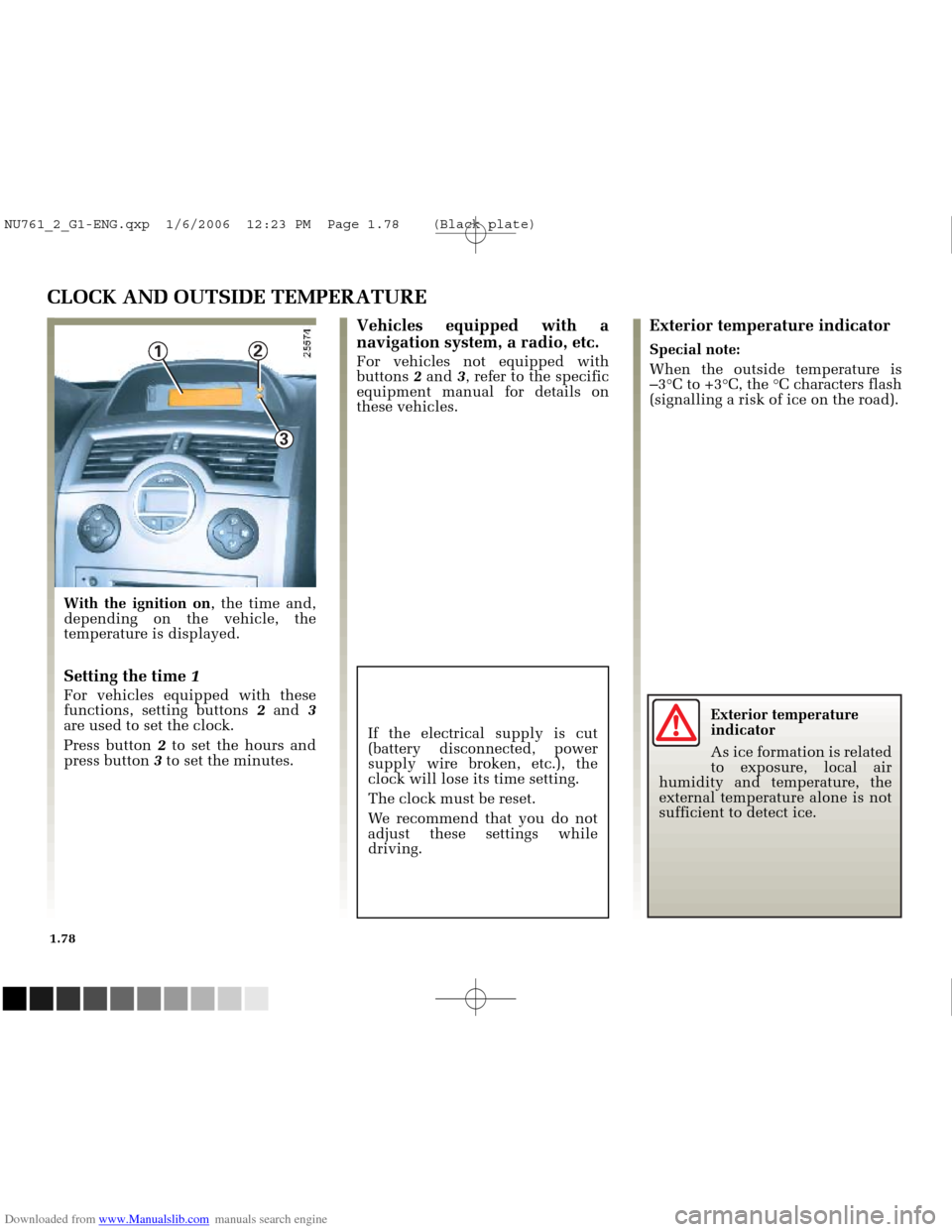
Downloaded from www.Manualslib.com manuals search engine
3
1
2
NU761_2_G1-FRA.qxd 10/11/05 15:55 Page 1.78
1.78
Exterior temperature
indicator
As ice formation is related
to exposure, local air
humidity and temperature, the
external temperature alone is not
sufficient to detect ice.
CLOCK AND OUTSIDE TEMPERATURE
Vehicles equipped with a
navigation system, a radio, etc.
For vehicles not equipped with
buttons 2and 3, refer to the specific
equipment manual for details on
these vehicles.
Exterior temperature indicator
Special note:
When the outside temperature is
–3°C to +3°C, the °C characters flash
(signalling a risk of ice on the road).
With the ignition on , the time and,
depending on the vehicle, the
temperature is displayed.
Setting the time 1
For vehicles equipped with these
functions, setting buttons 2and 3
are used to set the clock.
Press button 2to set the hours and
press button 3to set the minutes. If the electrical supply is cut
(battery disconnected, power
supply wire broken, etc.), the
clock will lose its time setting.
The clock must be reset.
We recommend that you do not
adjust these settings while
driving.
NU761_2_G1-ENG.qxp 1/6/2006 12:23 PM Page 1.78 (Black plate)
Page 188 of 250
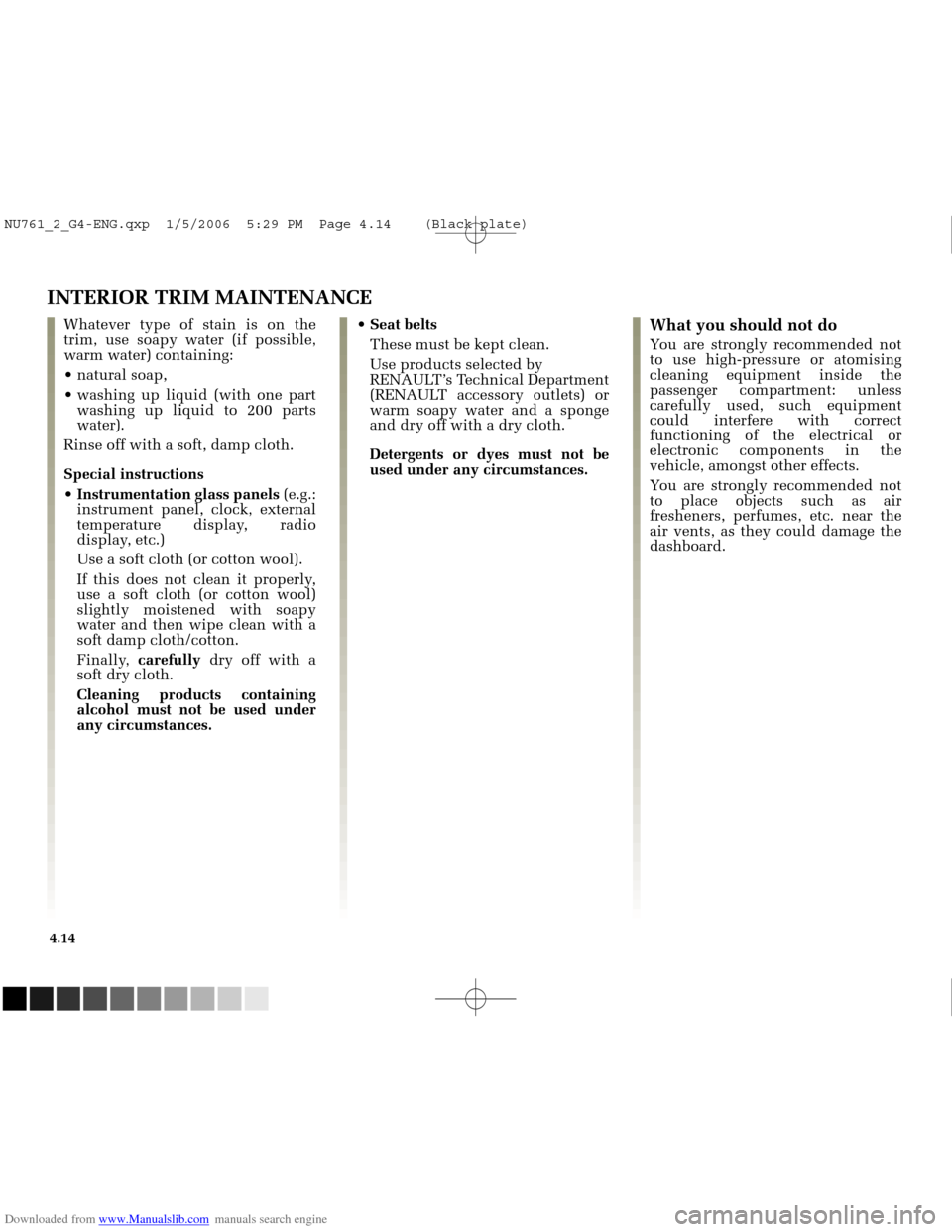
Downloaded from www.Manualslib.com manuals search engine
NU761_2_G4-FRA.qxd 14/11/05 10:11 Page 4.14
4.14
INTERIOR TRIM MAINTENANCE
Whatever type of stain is on the
trim, use soapy water (if possible,
warm water) containing:
natural soap,
washing up liquid (with one partwashing up liquid to 200 parts
water).
Rinse off with a soft, damp cloth.
Special instructions
Instrumentation glass panels (e.g.:
instrument panel, clock, external
temperature display, radio
display, etc.)
Use a soft cloth (or cotton wool).
If this does not clean it properly,
use a soft cloth (or cotton wool)
slightly moistened with soapy
water and then wipe clean with a
soft damp cloth/cotton.
Finally, carefully dry off with a
soft dry cloth.
Cleaning products containing
alcohol must not be used under
any circumstances. Seat belts
These must be kept clean.
Use products selected by
RENAULT’s Technical Department
(RENAULT accessory outlets) or
warm soapy water and a sponge
and dry off with a dry cloth.
Detergents or dyes must not be
used under any circumstances.What you should not do
You are strongly recommended not
to use high-pressure or atomising
cleaning equipment inside the
passenger compartment: unless
carefully used, such equipment
could interfere with correct
functioning of the electrical or
electronic components in the
vehicle, amongst other effects.
You are strongly recommended not
to place objects such as air
fresheners, perfumes, etc. near the
air vents, as they could damage the
dashboard.
NU761_2_G4-ENG.qxp 1/5/2006 5:29 PM Page 4.14 (Black plate)
Page 197 of 250
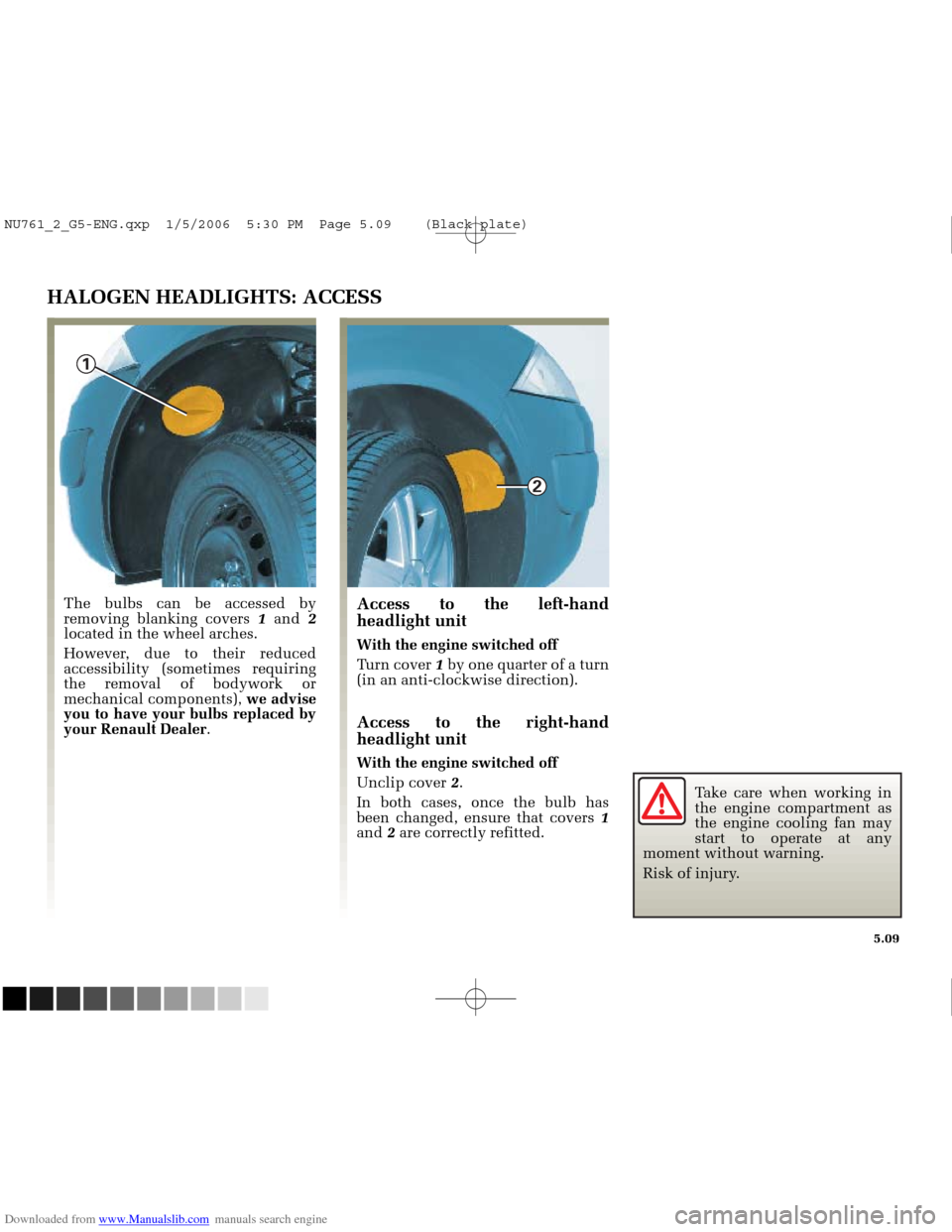
Downloaded from www.Manualslib.com manuals search engine
2
1
NU761_2_G5-FRA.qxd 4/11/05 11:09 Page 5.09
5.09
HALOGEN HEADLIGHTS: ACCESS
Access to the left-hand
headlight unit
With the engine switched off
Turn cover 1by one quarter of a turn
(in an anti-clockwise direction).
Access to the right-hand
headlight unit
With the engine switched off
Unclip cover 2.
In both cases, once the bulb has
been changed, ensure that covers 1
and 2 are correctly refitted.
The bulbs can be accessed by
removing blanking covers
1and 2
located in the wheel arches.
However, due to their reduced
accessibility (sometimes requiring
the removal of bodywork or
mechanical components), we advise
you to have your bulbs replaced by
your Renault Dealer .
Take care when working in
the engine compartment as
the engine cooling fan may
start to operate at any
moment without warning.
Risk of injury.
NU761_2_G5-ENG.qxp 1/5/2006 5:30 PM Page 5.09 (Black plate)
Page 209 of 250
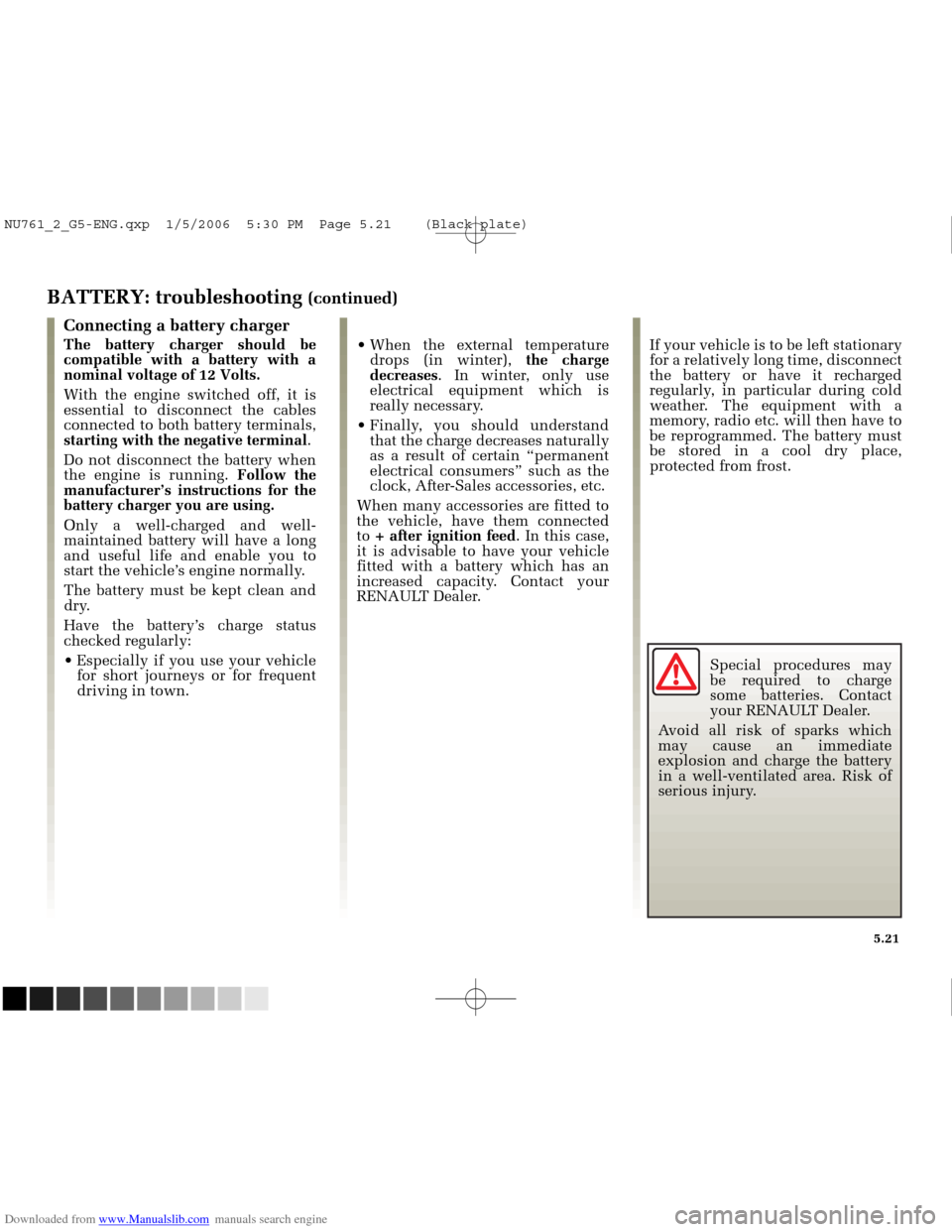
Downloaded from www.Manualslib.com manuals search engine
NU761_2_G5-FRA.qxd 4/11/05 11:09 Page 5.21
5.21
BATTERY: troubleshooting (continued)
Connecting a battery charger
The battery charger should be
compatible with a battery with a
nominal voltage of 12 Volts.
With the engine switched off, it is
essential to disconnect the cables
connected to both battery terminals,
starting with the negative terminal .
Do not disconnect the battery when
the engine is running. Follow the
manufacturer’s instructions for the
battery charger you are using.
Only a well-charged and well-
maintained battery will have a long
and useful life and enable you to
start the vehicle’s engine normally.
The battery must be kept clean and
dry.
Have the battery’s charge status
checked regularly:
Especially if you use your vehicle for short journeys or for frequent
driving in town. When the external temperature
drops (in winter), the charge
decreases . In winter, only use
electrical equipment which is
really necessary.
Finally, you should understand that the charge decreases naturally
as a result of certain “permanent
electrical consumers” such as the
clock, After-Sales accessories, etc.
When many accessories are fitted to
the vehicle, have them connected
to + after ignition feed . In this case,
it is advisable to have your vehicle
fitted with a battery which has an
increased capacity. Contact your
RENAULT Dealer. If your vehicle is to be left stationary
for a relatively long time, disconnect
the battery or have it recharged
regularly, in particular during cold
weather. The equipment with a
memory, radio etc. will then have to
be reprogrammed. The battery must
be stored in a cool dry place,
protected from frost.
Special procedures may
be required to charge
some batteries. Contact
your RENAULT Dealer.
Avoid all risk of sparks which
may cause an immediate
explosion and charge the battery
in a well-ventilated area. Risk of
serious injury.
NU761_2_G5-ENG.qxp 1/5/2006 5:30 PM Page 5.21 (Black plate)
Page 246 of 250
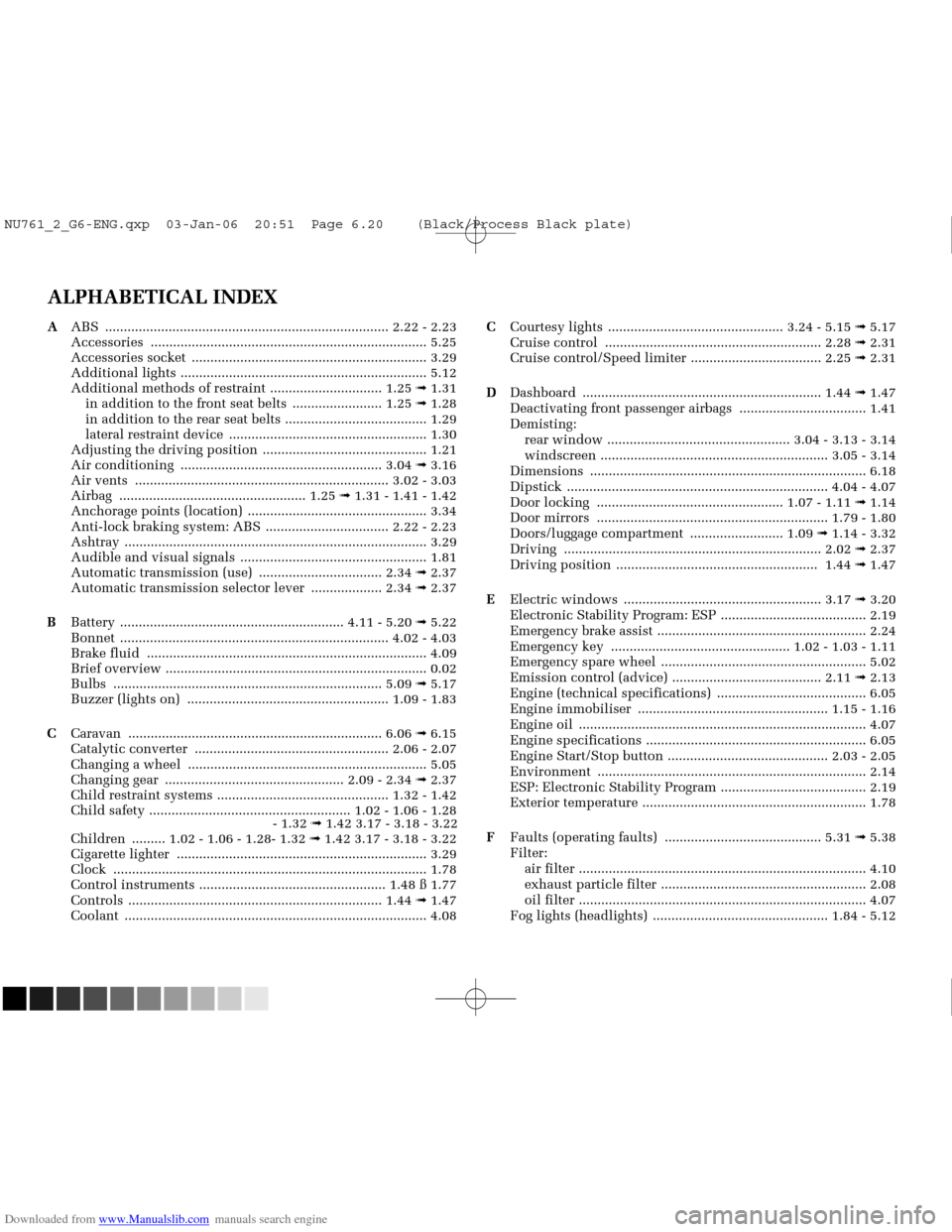
Downloaded from www.Manualslib.com manuals search engine
NU761_2_G6-FRA.qxd 4/11/05 11:11 Page 6.20
ALPHABETICAL INDEX
AABS ........................................................................\
.... 2.22 - 2.23
Accessories ............................................................\
.............. 5.25
Accessories socket ............................................................... 3.29
Additional lights .................................................................. 5.12
Additional methods of restraint .............................. 1.25 ➟ 1.31
in addition to the front seat belts ........................ 1.25 ➟ 1.28
in addition to the rear seat belts ...................................... 1.29
lateral restraint device ..................................................... 1.30
Adjusting the driving position ............................................ 1.21
Air conditioning ...................................................... 3.04 ➟ 3.16
Air vents .................................................................... 3.02 - 3.03
Airbag .................................................. 1.25 ➟ 1.31 - 1.41 - 1.42
Anchorage points (location) ................................................ 3.34
Anti-lock braking system: ABS ................................. 2.22 - 2.23
Ashtray ................................................................\
................. 3.29
Audible and visual signals .................................................. 1.81
Automatic transmission (use) ................................. 2.34 ➟ 2.37
Automatic transmission selector lever ................... 2.34 ➟ 2.37
B Battery ............................................................ 4.11 - 5.20 ➟ 5.22
Bonnet ........................................................................\
4.02 - 4.03
Brake fluid ........................................................................\
... 4.09
Brief overview ...................................................................... 0.02
Bulbs ..................................................................\
...... 5.09 ➟ 5.17
Buzzer (lights on) ...................................................... 1.09 - 1.83
C Caravan ................................................................\
.... 6.06 ➟ 6.15
Catalytic converter .................................................... 2.06 - 2.07
Changing a wheel ................................................................ 5.05
Changing gear ................................................ 2.09 - 2.34 ➟ 2.37
Child restraint systems .............................................. 1.32 - 1.42
Child safety ...................................................... 1.02 - 1.06 - 1.28 - 1.32➟ 1.42 3.17 - 3.18 - 3.22
Children ......... 1.02 - 1.06 - 1.28- 1.32 ➟ 1.42 3.17 - 3.18 - 3.22
Cigarette lighter ................................................................... 3.29
Clock ..................................................................\
.................. 1.78
Control instruments .................................................. 1.48 ß 1.77
Controls ...............................................................\
..... 1.44 ➟ 1.47
Coolant ................................................................\
................. 4.08 C
Courtesy lights ............................................... 3.24 - 5.15 ➟ 5.17
Cruise control .......................................................... 2.28 ➟ 2.31
Cruise control/Speed limiter ................................... 2.25 ➟ 2.31
D Dashboard ..............................................................\
.. 1.44 ➟ 1.47
Deactivating front passenger airbags .................................. 1.41
Demisting: rear window ................................................. 3.04 - 3.13 - 3.14
windscreen ............................................................. 3.05 - 3.14
Dimensions .............................................................\
............. 6.18
Dipstick ...................................................................... 4.04 - 4.07
Door locking .................................................. 1.07 - 1.11 ➟ 1.14
Door mirrors .............................................................. 1.79 - 1.80
Doors/luggage compartment ......................... 1.09 ➟ 1.14 - 3.32
Driving ................................................................\
..... 2.02 ➟ 2.37
Driving position ...................................................... 1.44 ➟ 1.47
E Electric windows ..................................................... 3.17 ➟ 3.20
Electronic Stability Program: ESP ....................................... 2.19
Emergency brake assist ........................................................ 2.24
Emergency key ................................................ 1.02 - 1.03 - 1.11
Emergency spare wheel ....................................................... 5.02
Emission control (advice) ........................................ 2.11 ➟ 2.13
Engine (technical specifications) ........................................ 6.05
Engine immobiliser ................................................... 1.15 - 1.16
Engine oil ........................................................................\
..... 4.07
Engine specifications ........................................................... 6.05
Engine Start/Stop button ........................................... 2.03 - 2.05
Environment ............................................................\
............ 2.14
ESP: Electronic Stability Program ....................................... 2.19
Exterior temperature ............................................................ 1.78
F Faults (operating faults) .......................................... 5.31 ➟ 5.38
Filter: air filter ........................................................................\
..... 4.10
exhaust particle filter ....................................................... 2.08
oil filter ........................................................................\
..... 4.07
Fog lights (headlights) ............................................... 1.84 - 5.12
NU761_2_G6-ENG.qxp 03-Jan-06 20:51 Page 6.20 (Black/Process Black\
plate)